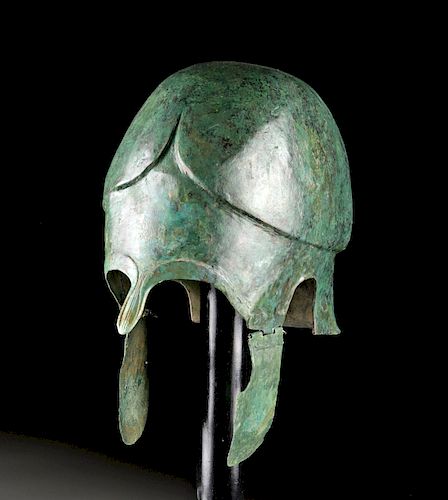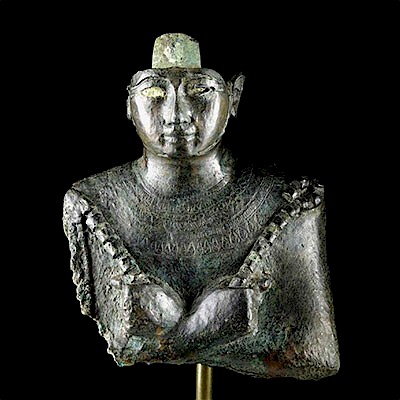Published / Exhibited Greek Chalcidian Bronze Helmet
Lot 24
About Seller
Artemis Fine Arts
686 S Taylor Ave, Ste 106
Louisville, CO 80027
United States
Selling antiquities, ancient and ethnographic art online since 1993, Artemis Gallery specializes in Classical Antiquities (Egyptian, Greek, Roman, Near Eastern), Asian, Pre-Columbian, African / Tribal / Oceanographic art. Our extensive inventory includes pottery, stone, metal, wood, glass and textil...Read more
Estimate:
$40,000 - $60,000
Absentee vs Live bid
Two ways to bid:
- Leave a max absentee bid and the platform will bid on your behalf up to your maximum bid during the live auction.
- Bid live during the auction and your bids will be submitted real-time to the auctioneer.
Bid Increments
| Price | Bid Increment |
|---|---|
| $0 | $25 |
| $300 | $50 |
| $1,000 | $100 |
| $2,000 | $250 |
| $5,000 | $500 |
| $10,000 | $1,000 |
| $20,000 | $2,500 |
| $50,000 | $5,000 |
| $100,000 | $10,000 |
| $200,000 | $20,000 |
About Auction
By Artemis Fine Arts
May 22, 2019
Set Reminder
2019-05-22 10:00:00
2019-05-22 10:00:00
America/New_York
Bidsquare
Bidsquare : Exceptional Day 1: Antiquities Asian Fine Art
https://www.bidsquare.com/auctions/artemis-gallery/exceptional-day-1-antiquities-asian-fine-art-4129
Day 1 of an important 2-day auction featuring exceptional art from around the world - Egyptian, Greek, Etruscan, Roman, Viking, Russian, Near Eastern; Asian Art from China, Japan, Thailand, Vietnam, Burma, India; Fine Art from the 17th century to present. Artemis Fine Arts info@artemisgallery.com
Day 1 of an important 2-day auction featuring exceptional art from around the world - Egyptian, Greek, Etruscan, Roman, Viking, Russian, Near Eastern; Asian Art from China, Japan, Thailand, Vietnam, Burma, India; Fine Art from the 17th century to present. Artemis Fine Arts info@artemisgallery.com
- Lot Description
Greece, Classical Period, ca. 5th to 4th century BCE. A striking Chalcidian helmet comprised of hammered tinned bronze, so named as this helmet form was initially depicted on pottery believed to derive from the Euboean city of Chalcis. This form of helmet is distinguished by its curved cheekpieces, attached here by thin bronze pins that form a hinge. A teardrop-shaped nose guard extends down from raised curves demarcating the eyes. The forehead has a sweeping central ridge and an overhanging brow line. Curves on the sides allow the ears to be left open, improving battlefield communication. Uniquely, this example has incised square motifs on the exterior of its earflaps - these look like a personal touch, perhaps made by the helmet's original owner as an identification mark. Size: 10.45" L x 4.75" W x 9.75" H (26.5 cm x 12.1 cm x 24.8 cm); 17.35" H (44.1 cm) on included custom stand.
During this time period, Greece was divided into city states who warred with one another and foreign powers like Persia. Alongside the remarkable artistic and philosophical achievements that we remember today, innovations in weaponry and armor changed the nature of war. The Chalcidian helmet was an improvement over the earlier Corinthian style, allowing improved hearing and vision. Mass production of bronze items like this helmet and shields led to the creation of the phalanx, a wave of intimidating shielded warriors marching side by side. Each helmet of this style was made to fit its wearer's head. The interior would have been lined with leather to serve as a cushion against blows (and against the uncomfortable metal rubbing on top of someone's head!). The owner would have hung the helmet in his home and would have been buried with it after his death. When worn, it probably had some kind of adornment like a feather comb. This style was still being worn by some soldiers, notably hoplites, during the time of Alexander the Great.
Exhibited in "Dressed to Kill in Love and War: Splendor in the Ancient World", February 1 - March 31, 2019, Academy Art Museum, Maryland, USA, published in the exhibition guide by Sarah E. Cox and Anke Van Wagenberg, fig. 6.
See a nearly identical example in the Walters Art Museum, Baltimore, USA: https://art.thewalters.org/detail/22640/chalcidian-type-helmet/
Provenance: private East Coast, USA collection; Exhibited in "Dressed to Kill in Love and War: Splendor in the Ancient World", February 1 - March 31, 2019, Academy Art Museum, Maryland, USA, published in the exhibition guide by Sarah E. Cox and Anke Van Wagenberg, fig. 6; ex-private Texas, USA collection, acquired in the 1990s
All items legal to buy/sell under U.S. Statute covering cultural patrimony Code 2600, CHAPTER 14, and are guaranteed to be as described or your money back.
A Certificate of Authenticity will accompany all winning bids.
We ship worldwide and handle all shipping in-house for your convenience.
#146071Piece has been repaired and restored, notably on the top of the head, one side of the neck guard, and the cheek guards. See the X-Rays in the photos for a view of this. Approximately 75% original material. Mottled pale green patina on surface. Hinges are present but very fragile. The helmet is slightly crushed along its vertical axis as a result of being buried.Condition
- Shipping Info
-
All shipping is handled in-house for your convenience. Your invoice from Artemis Gallery will include shipping calculation instructions. If in doubt, please inquire BEFORE bidding for estimated shipping costs for individual items.
-
- Buyer's Premium



 EUR
EUR CAD
CAD AUD
AUD GBP
GBP MXN
MXN HKD
HKD CNY
CNY MYR
MYR SEK
SEK SGD
SGD CHF
CHF THB
THB

















